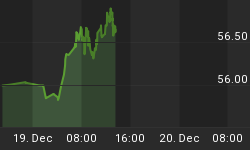Market analysis doesn't need to be too complicated to be good, and probably simpler is better. Heck, we have just spent the past 12 months listening to every analyst, commentator and pundit under the sun tell us why this market is the buy of the century, and when I look at the numbers, I note the S&P500 is up only 3.68% over the past 52 weeks. That's a lot of verbage for so little beef. If you have been holding the S&P500 for 52 weeks, you have made 3.68% on your money. That's a fact, not an opinion.
So what's the message here? Simply stated, a market that has gone nowhere for the past 52 weeks is at risk for lower prices. Just take a 52 week rate of change indicator and slap it on any chart and see what I am talking about. It really is that simple. Now this isn't meant to show you some "holy grail" type of indicator that will have you buying at the exact bottom tick. This isn't the purpose of my analysis. But the important point is this: once the 52 week rate of change turns negative - that is, your investment is underwater from a year ago - the 52 week rate of change tends to stay negative for a long while.
Figure 1 is a weekly chart of the S&P500 (symbol: $INX). The 52 week rate of change indicator is in the bottom panel. The current value is above the zero line. The thick vertical lines identify those times (in recent market history) when the 52 week rate of change turned negative. The dashed vertical lines identify times when the indicator got below 1% (but did not turn negative), and these were very good buying points during the bull market seen during the middle part of the decade.
Figure 1. $INX/ weekly

Once again, we aren't establishing a "buy signal" or "sell signal" but showing you that once the 52 week rate of change turns negative it tends to stay that way for awhile. But let's look at this notion a little more closely, and to do this I am going to introduce an indicator that counts the number of weeks that the 52 week rate of change is negative. This is the indicator in the lower panel of figure 2, a weekly chart. So when the 52 week rate of change first turns negative, the indicator changes from blue to red. Figure 2 is from 1987 to the present, and the indicator has turned from blue to red 5 times (see vertical bars on figure). What is surprising is that in 4 of those instances the indicator rose continuously for greater than 20 weeks.
Figure 2. $INX/ weekly
So what can we draw from these observations? Once a trend is started -i.e., lower prices in this case as the 52 rate of change has turned negative - it tends to persist.
Figure3 shows the S&P500 from 1966 to 1987, and our indicator is in the bottom panel. The indicator has gone from blue to red 8 times. In 6 instances, the persistence of the trend is noteworthy; the indicator continued to rise because prices went lower or sideways.
Figure 3. $INX/ weekly
So why is this relevant since the S&P500 is 3.68% above the zero line? Well let's look at some sector ETF charts, like the S&P Select Financial Spdr Fund (symbol: XLF) and the Semiconductor Holders (symbol: SMH) --everyone's two favorite proxies of market health. Figure 3 is a weekly chart of XLF with our indicator that looks at persistence of the down trend in the 52 week rate of change. Figure 4 is a weekly chart of SMH.
Figure 4. XLF/ weekly
Figure 5. SMH/ weekly
What we notice that the indicator in both SMH and XLF has started to rise as the 52 week rate of change has turned negative. For the most part, past instances where the 52 week rate of change has turned have persisted, and I don't see any reason why this time should be different.
So what's the message? Sometimes simpler is better. Trends tend to persist. Market tops are really about time.















